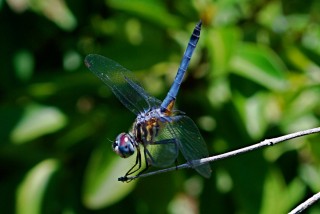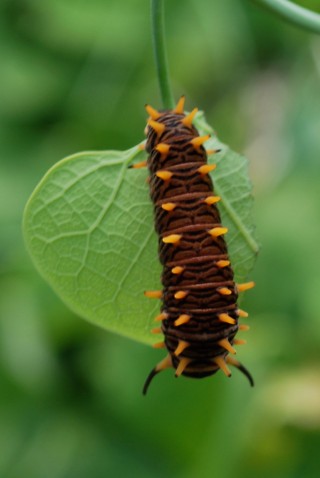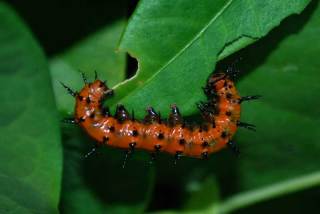There aren’t a ton of animals visible in the steamy sunny heat of late June here in Boca; those few that there are, apart from the omnipresent mockingbird and his counterpart in red, the cardinal, tend to be insects. Here’s a blue dasher dragonfly that seems to favor a perch on the spicewood tree on the side of our house:
As you can see from the red eyes, this is a not-quite-mature male (the adult male has green eyes). But he’s got the adult male body coloration: blue abdomen with black on the tip, and yellow on the sides of the first few abdominal segments. Females are brown and yellow, but tend to turn blue as they age. They usually retain the yellow stripes that run down the dorsal side on the majority of the abdominal segments, though, which helps differentiate a “blue” female from a juvenile male. For more on this, visit buguide.net’s blue dasher page.
The blue dasher is a widespread species in the United States, occurring from Florida and the Bahamas all the way out west to California, and north as far as southern British Columbia in the west to Ontario in the east. In other words, just about wherever you live in the lower 48, you have a good chance of encountering this species, although it is apparently absent from the Dakotas and the Rocky Mountain states.
Apart from the lovely anisopterans, the other insect we get in droves here is one of Eric’s favorites: butterflies! (He calls them lellerflies, as near as I can make out. He’s not actually referring to the lepidopterans around here; his gymnastics lessons have him “reach for your butterflies”; i.e., reach your arms straight over your head, in preparation for “making your pizzas,” which means planting your hands on the floor in front of you. All of this is to position you properly to allow you to turn a somersault. Just don’t try it with real pizzas, please!)
And here’s a lellerfly in potentio, a Polydamas swallowtail (Battus polydamas):
As you can see, he’s fatter than the Dutchman’s pipe (Aristolochia gigantea) leaf he’s feeding on! For the life history of this guy, visit the UF/IFAS web page; for many better photos, use bugguide.net.
From the archives, here’s another common caterpillar we get this time of year (although this archive shot was from December–while the summers can be a bit muggy, Florida winters are da bomb!):
The gulf fritillary (Agraulis vanillae) is a very pretty adult, and the larval form is one of the more attractive critters among lepidopterans. Certainly friendlier looking than the big old swallowtail larva above, although apparently its diet of passiflora species (Passiflora incarnata in our yard) renders it noxious, as its bright orange and black coloration (an aposematic combination) would suggest.
So go on, get out into the real world, even if it is a little hot, and a little muggy, and a little buggy. It’ll do you some good!



